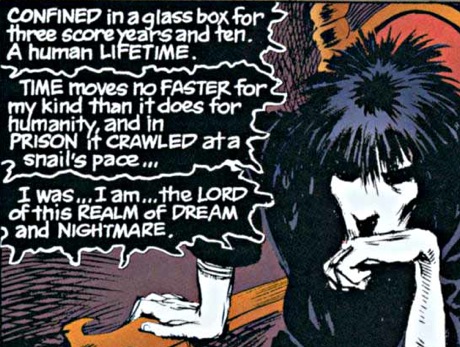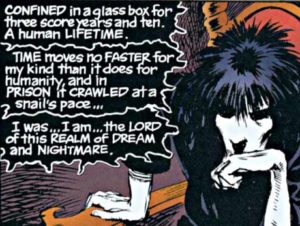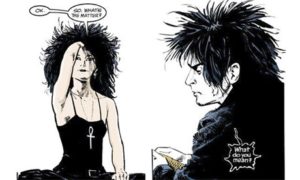Neil Gaiman often tells a story familiar to many of us who grew up reading comics. As the story goes, young Neil Gaiman, in his school’s guidance counselor’s office in Great Britain, is asked the question we all remember getting asked: “What do you want to do when you grow up?” L’il Neil’s response? “I want to write American comic books.” As Gaiman tells the story, his stammering counselor replied, “Have you considered accountancy?”
L’il Neil clearly did not consider accountancy, and instead made a name for himself as the most critically acclaimed writer in comic books, whose landmark SANDMAN series revitalized the notion of comic books as literature, and who has since crossed over into prose novels, television in film with unprecedented success.
Neil Gaiman found his way to DC Comics via the publisher’s New Talent Search program in Great Britain, following the great success of Alan Moore on SWAMP THING. Gaiman, who had already published some notable comics work, including taking over for Moore on Eclipse’s MIRACLEMAN and the graphic novels VIOLENT CASES, SIGNAL TO NOISE and MR. PUNCH with collaborator Dave McKean, was given a list of dormant DC properties that he could tackle, with the hopes of breathing new life into them as Moore had done on SWAMP THING. Gaiman’s first project, BLACK ORCHID, again with Dave McKean, was positively received but hardly a sensation. It would be Gaiman’s next attempt that would catapult him from little-known British newcomer to comics’ #1 writer: THE SANDMAN.
There had been previous “Sandman” characters at DC before: a 1940s cloaked mystery man (later turned into a standard tights-wearing superguy) and a psychedelic hero created in the 1970s by Joe Simon and Jack Kirby. However, Gaiman was given strict marching orders by his new editors: keep the name, but make everything else new. Left to his own devices, Gaiman first came up with his protagonist, Lord Morpheus, a.k.a. the immortal Lord of Dreams (who, by the way, is almost never called “The Sandman” in the work itself) and not long after began developing his own mythology in the Endless, Morpheus’s brothers and sisters, anthropomorphic representations of mankind’s fears, hopes and driving forces: Destiny, Death, Destruction, Despair, Delight and Delirium.
Made up of 10 graphic-novel collections, SANDMAN takes the reader though Morpheus’ interactions with humanity, some minor and some major. Gaiman varies the tone of his stories widely, from a hunt for rogue nightmares in THE DOLL’S HOUSE to a bidding war for Hell itself in SEASON OF MISTS. Along the way, we find out more about Morpheus’s past over the centuries, his tragic love affairs with mortal women, and the vendettas among his own kin that would eventually become his undoing. But in a larger metatextual sense, what SANDMAN is really about is the very nature of storytelling, how we create stories for ourselves in our own lives to inspire or delude ourselves, and how that happens at the most primal level when we dream.
The popularity of SANDMAN prompted DC to create a separate imprint for its dark fantasy/horror books called Vertigo, whose launch was inaugurated by another series of Gaiman’s, DEATH; THE HIGH COST OF LIVING, a solo miniseries starring Morpheus’s older sister. Probably the most popular character in Gaiman’s SANDMAN, Death takes the form of a plucky, lovable 16-year-old girl with Goth-ish eye makeup and an ankh around her neck, and goes about her duties of escorting immortals to the afterlife not by the glowering point of the scythe, but with a friendly slip through the arm. In one of the most heartbreaking moments in the entire series, we see one of the mortals visited by Death struggling with the unfairness of the situation. “Is that all? Is that all I get?” she asks?
“You get what everyone gets,” replies Death evenly but not unsympathetically. “You get a lifetime.”
SANDMAN was an anomaly at DC, with a heavy female readership, many of whom were not at all habitual comics readers. The success of SANDMAN in collected graphic novel format certainly helps continually cultivate new readership, and also prompted DC to more heavily market their comics in the collected format at mass media outlets like Barnes & Noble.
Gaiman elected to end his series with issue #80, building SANDMAN to a grand crescendo with the death and rebirth of its title character. Since its finale, Gaiman has only dabbled in comics sporadically, with the most high-profile work being 1602, a transplantation of Marvel’s cast of superheroic characters to Elizabethan England. Most of Gaiman’s time these days is spent on novels, such as AMERICAN GODS and ANANSI BOYS, and film, like the adaptation of his and Charles Vess’ graphic novel STARDUST and the Gaiman-scripted CGI-rendered BEOWULF. However, from time to time Gaiman decides to grace the comics world with his presence, and it’s always a welcome treat.




Comments are closed.